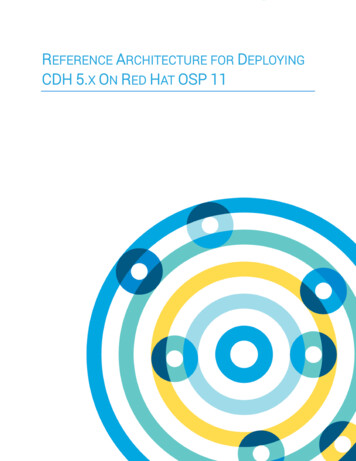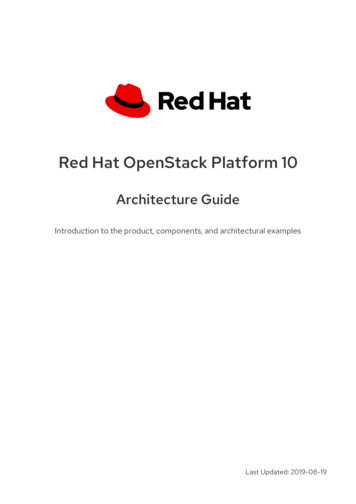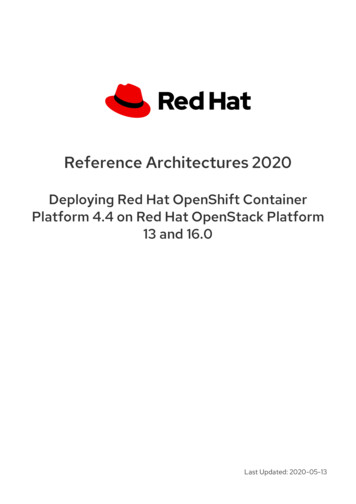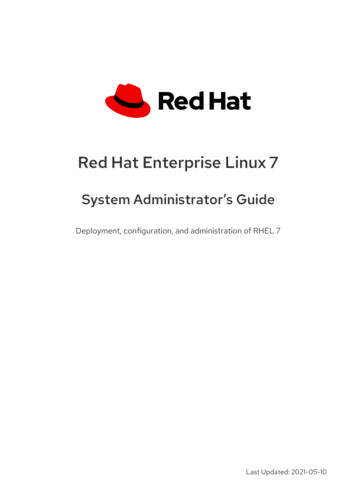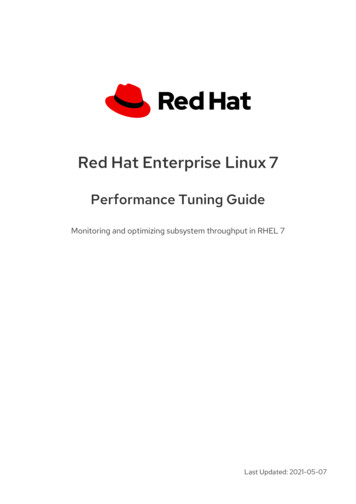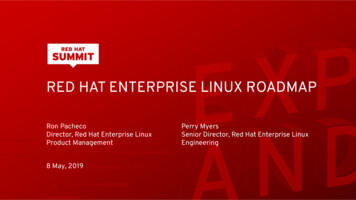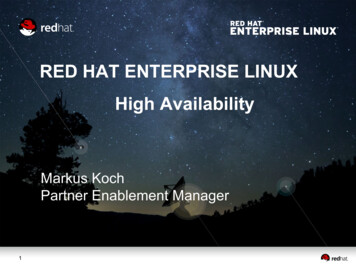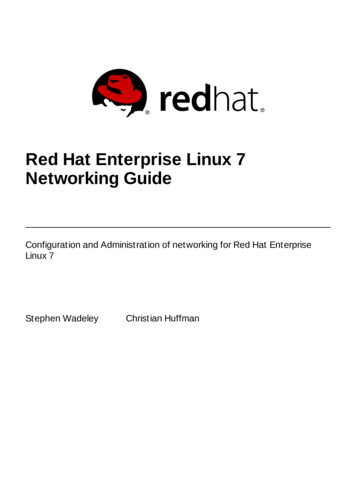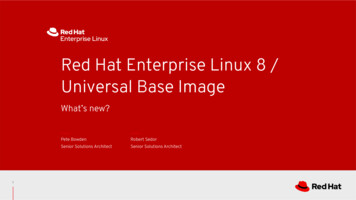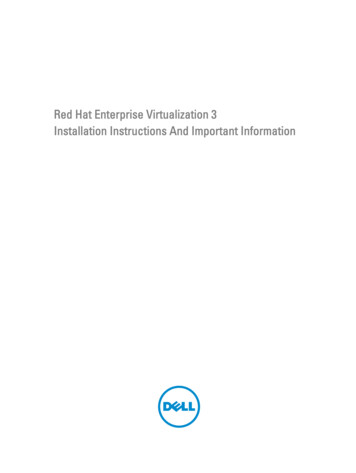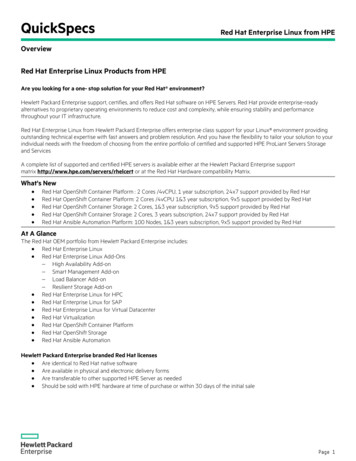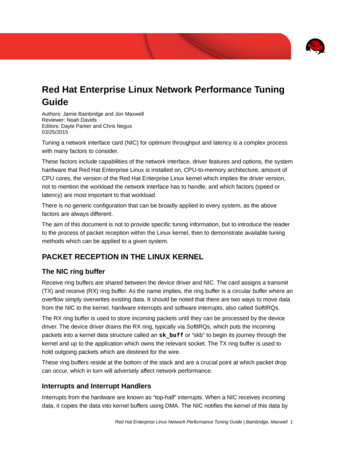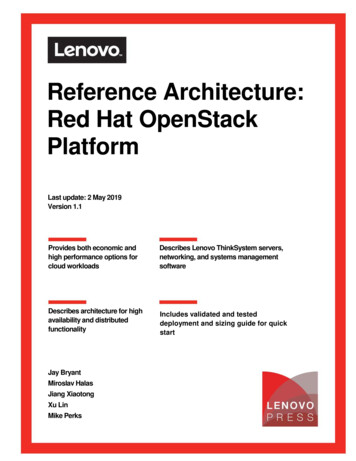
Transcription
Reference Architecture:Red Hat OpenStackPlatformLast update: 2 May 2019Version 1.1Provides both economic andhigh performance options forcloud workloadsDescribes Lenovo ThinkSystem servers,networking, and systems managementsoftwareDescribes architecture for highavailability and distributedfunctionalityIncludes validated and testeddeployment and sizing guide for quickstartJay BryantMiroslav HalasJiang XiaotongXu LinMike PerksClick here to check for updates
Table of Contents1Introduction. 12Business problem and business value . 22.1Business problem . 22.2Business value . 23Requirements. 33.1Functional requirements . 33.2Non-functional requirements . 34Architectural overview . 65Component model . 75.1Core Red Hat OpenStack Platform components. 75.2Third-party components . 105.3Red Hat Ceph Storage Component . 105.4Red Hat OpenStack Platform specific benefits . 116Operational model . 136.16.1.1Rack servers . 136.1.2Network switches introduction . 156.2Deployment of an OpenStack cluster. 166.2.1Utility node . 186.2.2Compute nodes . 186.2.3Hyper Converged Compute nodes . 196.2.4Controller nodes . 206.2.5Controller cluster. 206.2.6Support services . 226.2.7Deployment model . 226.3iiHardware . 13Storage . 246.3.1Deployment without a Ceph Cluster (Swift-in-Controller) . 266.3.2Deployment with a traditional Red Hat Ceph Cluster . 266.3.3Deployment with a Hyperconverged Infrastructure Ceph Cluster . 27Reference Architecture: Red Hat Enterprise Linux OpenStack Platformversion 1.1
6.4Networking . 286.5Systems Management . 2976.5.1Lenovo XClarity Administrator . 296.5.2Red Hat CloudForms . 30Deployment Example . 327.1Lenovo hardware preparation . 327.2Networking . 337.3 Best practices for Preparing to Deploy OpenStack Platform 13 to LenovoThinkSystem Servers . 368Appendix: Lenovo Bill of Materials . 388.1Server BOM . 388.1.1Utility Node . 388.1.2Controller Node. 388.1.3Controller Node (Swift-in-Controller Configuration) . 398.1.4Compute Node. 398.1.5Hyper-converged Node . 408.2Networking BOM . 408.2.1NE0152T 1GbE Switch . 408.2.2NE1032 10GbE Switch . 408.2.3NE1032T 10GbE Switch . 408.2.4NE1072T 10GbE Switch . 408.3Rack BOM. 418.4Red Hat Subscription Options . 419Resources . 42iiiReference Architecture: Red Hat Enterprise Linux OpenStack Platformversion 1.1
1 IntroductionOpenStack continues to gain significant traction in the industry because of the growing adoption of cloudusage and the flexibility OpenStack offers as an open source product This document describes the referencearchitecture (RA) for deploying the Red Hat OpenStack Platform on industry leading servers, storage,networking, and systems management tools from Lenovo.Lenovo and Red Hat have collaborated to promote best practices and validate reference architecture fordeploying private cloud infrastructures by leveraging the Red Hat OpenStack Platform 13. The Red HatOpenStack Platform provides a foundation to build a private or public Infrastructure as a Service (IaaS) cloudon top of Red Hat Enterprise Linux and offers a scalable, highly available platform for the management ofcloud-enabled workloads. Red Hat OpenStack Platform 13 simplifies the process of deploying an OpenStackcloud via its comprehensive deployment automation and documentation.The Lenovo hardware platform provides an ideal infrastructure solution for cloud deployments. These serversprovide the full range of form factors, features and functions that are necessary to meet the needs of smallbusinesses all the way up to large enterprises. Lenovo uses industry standards in systems management onall these platforms, which enables seamless integration into cloud management tools such as OpenStack.Lenovo also provides data center network switches that are designed specifically for robust, scale-out serverconfigurations and converged storage interconnect fabrics.The target environments for this reference architecture include Managed Service Providers (MSPs), CloudService Providers (CSPs), and enterprise private clouds that require a complete solution for cloud IaaSdeployment and management based on OpenStack.This document features planning, design considerations, performance, and workload density for implementingRed Hat OpenStack Platform on the Lenovo hardware platform. Using this RA, organizations can easily adoptOpenStack to simplify the system architecture, reduce deployment and maintenance costs, and address thelack of convergence in infrastructure management. The reference architecture focuses on achieving optimalperformance and workload density by using Lenovo hardware while minimizing procurement costs andoperational overhead.OpenStack and other Red Hat branded software such as Red Hat CloudForms are deployed on the Lenovohardware platform to instantiate compute, network, storage, and management services. The LenovoXClarity Administrator solution consolidates systems management across multiple Lenovo servers thatspan the data center. XClarity enables automation of firmware updates on servers via compliance policies,patterns for system configuration settings, hardware inventory, bare-metal OS and hypervisor provisioning,and continuous hardware monitoring. OpenStack can easily integrate with XClarity using the published RESTAPI.The intended audience for this document is IT professionals, technical architects, sales engineers, andconsultants. Readers are expected to have a basic knowledge of Red Hat Enterprise Linux and OpenStack.1Reference Architecture: Red Hat Enterprise Linux OpenStack Platformversion 1.1
2 Business problem and business valueThis chapter outlines the value proposition of the Red Hat OpenStack Platform with Lenovo hardware.2.1 Business problemMSPs and CSPs face intense challenges that drive them to look for economic but scalable infrastructuresolutions that enable cost-effective IT services while easily expanding capacity to meet user demand.OpenStack provides an open source alternative for cloud management that is increasingly used to build andmanage cloud infrastructures to support enterprise operations. OpenStack’s licensing structure reduces theinitial acquisition and expansion costs when compared to other cloud technologies. However, ITAdministrators require robust skill sets to build an advanced cloud service that is based on OpenStack’sflexibility and various deployment and configuration options. Moreover, scale out of such a cloud clusterintroduces risk of an unbalanced infrastructure that may lead to performance issues, insufficient networkbandwidth, or increased exposure to security vulnerabilities.2.2 Business valueThe Red Hat OpenStack Platform reference architecture solves the problems described in section 2.1 byproviding a blueprint for accelerating the design, piloting, and deployment process of an enterprise-levelOpenStack cloud environment on Lenovo hardware. The reference architecture reduces the complexity ofOpenStack deployments by outlining a validated system configuration that scales and delivers an enterpriselevel of redundancy across servers, storage and networking to help enable HA. This document provides thefollowing benefits: Consolidated and fully integrated hardware resources with balanced workloads for compute, network, andstorage. An aggregation of compute and storage hardware, which delivers a single, virtualized resource poolcustomizable to different compute and storage ratios to meet the requirements of various solutions. Ease of scaling (vertical and horizontal) based on business requirements. Compute and storageresources can be extended at runtime. Elimination of single points of failure in every layer by delivering continuous access to virtual machines(VMs). Hardware redundancy and full utilization. Rapid OpenStack cloud deployment, including updates, patches, security, and usability enhancementswith enterprise-level support from Red Hat and Lenovo. Unified management and monitoring for VMs.2Reference Architecture: Red Hat Enterprise Linux OpenStack Platformversion 1.1
3 RequirementsThe requirements for a robust cloud implementation are described in this section.3.1 Functional requirementsPublic and Private clouds should meet a number of requirements to provide users and administrators with apositive user experience. Table 1 lists the functional requirements for a cloud implementation.Table 1. Functional requirementsRequirementDescriptionSupported byMobilityWorkload is not tied to any physical locationEnabled VM is booted from distributedstorage and runs on different hosts Live migration of running VMs Rescue mode support for hostmaintenanceResource provisioningPhysical servers, virtual OpenStack compute servicemachines, virtual storage, and OpenStack block storage servicevirtual network can be OpenStack network serviceprovisioned on demand OpenStack bare-metal provisioningserviceManagement portalWeb-based dashboard for workloads managementMulti-tenancyResources are segmentedroutine management operations based on tenancyMeteringCollect measurements of usedOpenStack dashboard (Horizon) for mostBuilt-in segmentation and multi-tenancy inOpenStack OpenStack
Reference Architecture: Red Hat OpenStack Platform Provides both economic and high performance options for cloud workloads Describes Lenovo ThinkSystem servers, networking, and systems management software Describes architecture for high availability and distributed functionality Includes validated and tested deployment and sizing guide for quick start Jay Bryant Miroslav Halas Jiang
